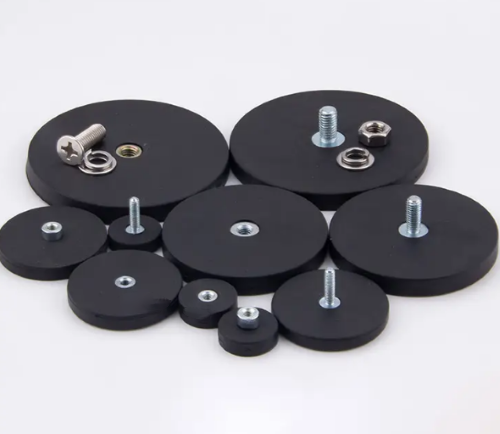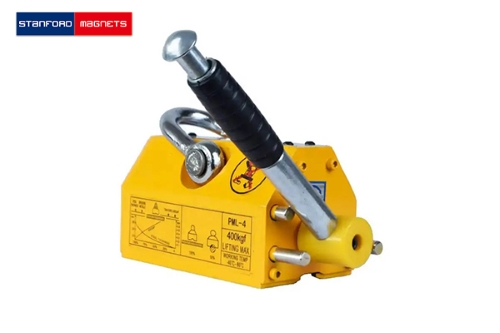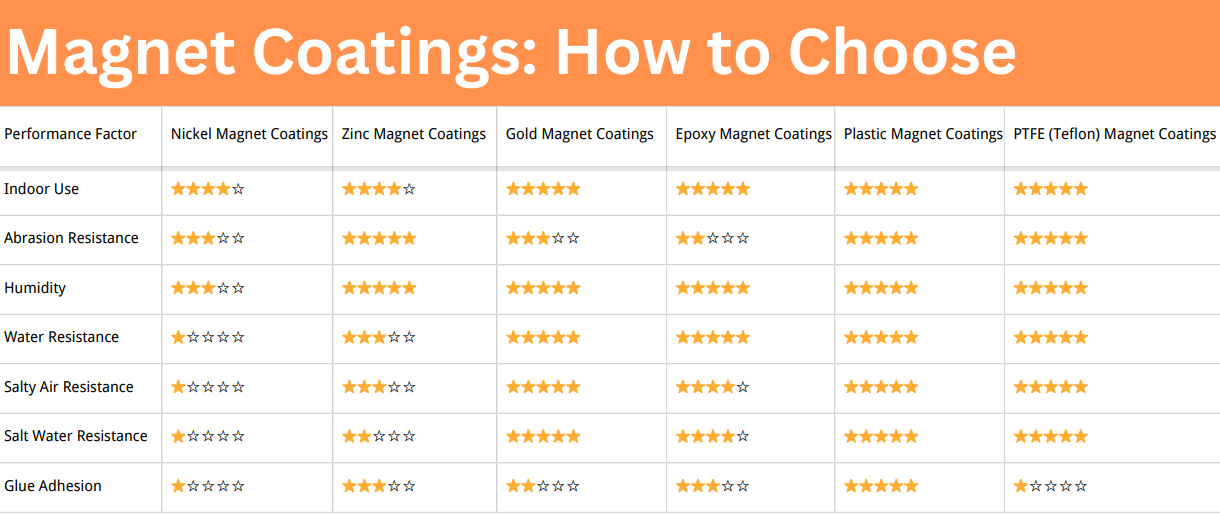Rubber-Coated Magnets: A Comprehensive Overview
Rubber-coated magnets are a versatile and widely used component in various industrial applications. The process of coating magnets with rubber not only enhances their physical properties but also provides several functional advantages. This article will offer a comprehensive guide on rubber-coated magnets, their benefits, and the key considerations for their use in different industrial settings.
What Are Rubber-Coated Magnets
A rubber-coated magnet is simply a magnet—usually made of materials like neodymium, ferrite, or rare-earth alloys—that is covered with a layer of rubber (or elastomeric materials). The rubber coating can vary in thickness and type, with common materials including natural rubber, neoprene, silicone rubber, and polyurethane.

The process of coating magnets with rubber is typically done by applying a layer of liquid rubber onto the magnet, which is then allowed to cure or harden. This coating serves multiple purposes, such as providing a protective barrier against the environment, enhancing grip, reducing the risk of damage to surfaces, and extending the life of the magnet.
Further reading: Types of Neodymium Magnet Coatings: Protecting the World's Strongest Magnets
Benefits of Rubber-Coated Magnets
- Surface Protection and Durability First, the rubber coating provides a layer of protection for both the magnet and the surfaces it interacts with. This protective layer helps to prevent scratches, dents, and damage that might otherwise occur with the direct contact of bare magnets.
- Magnet Protection: Magnets, especially those made of neodymium, can be fragile and prone to cracking or chipping. A rubber coating absorbs impacts and reduces the likelihood of magnet breakage.
- Surface Protection: Rubber-coated magnets are less likely to damage delicate surfaces like glass, wood, or metal. For example, in applications where the magnets are used on walls, machinery, or other sensitive items, the rubber layer ensures no scratches or scuffing.
- Increased Grip and Safety Rubber coatings improve the grip of magnets, making them easier to handle and less likely to slip or slide when applied to a surface. This is particularly important in industrial settings where magnets need to hold heavy or large objects in place.
- Safety: The rubber coating helps to reduce the risk of injury from sharp magnet edges. In environments where people are regularly handling magnets, the coating provides a safer tactile experience, preventing cuts or abrasions.
- Non-Slip Surfaces: The rubber coating offers a non-slip surface, making the magnet ideal for applications requiring strong hold but minimal movement or displacement.
- Weather and Chemical Resistance Rubber-coated magnets are often used in outdoor or harsh environments where exposure to the elements, chemicals, and varying temperatures can degrade the performance of uncoated magnets.
- Weather Resistance: Rubber coatings can protect the magnet from moisture, UV rays, dust, and dirt, making them suitable for outdoor industrial applications.
- Chemical Resistance: Certain types of rubber, such as neoprene or silicone, are resistant to oils, solvents, and acids, making them ideal for industrial applications where exposure to harsh chemicals is a concern.
- Noise Reduction The rubber coating can help reduce noise generated by the magnet's interaction with metal or other hard surfaces. This is especially beneficial in industrial and manufacturing settings where loud, repetitive noise can be disruptive. The coating absorbs some of the vibrations, leading to quieter operation.
- Enhanced Aesthetic Appeal Although primarily used for functional purposes, rubber-coated magnets can also improve the aesthetic appeal of industrial equipment. The rubber layer can be molded in various colors, providing a more polished and professional look for magnets used in industrial machinery or factory settings.
Industrial Applications of Rubber-Coated Magnets
Magnetic Lifting and Handling Systems Rubber-coated magnets are extensively used in magnetic lifting and handling systems within manufacturing plants, warehouses, and logistics industries. The rubber coating helps prevent damage to the lifted objects while providing a strong magnetic hold. These systems are typically used for lifting and positioning metal sheets, plates, or machinery parts during assembly, fabrication, or transport.

In heavy manufacturing, rubber-coated magnets can be used to lift steel plates or industrial machinery parts. The coating ensures that the magnets don't cause any scratches or dents on the surfaces of the materials being moved.
Magnetic Separation Systems In industries like mining, recycling, and food production, rubber-coated magnets are used in magnetic separation systems to remove ferrous contaminants from materials. These systems are designed to pull metal contaminants from raw materials, such as ores, grains, or waste products, ensuring cleaner, safer end products.
In a recycling plant, rubber-coated magnets help separate metal debris from non-ferrous materials like plastic or paper, improving the quality of the recycled material and reducing wear and tear on machinery.
Industrial Conveyors and Automation Rubber-coated magnets are often integrated into conveyor systems and automated sorting lines to facilitate the movement of metallic objects through the production process. The rubber coating ensures that the magnets can securely grip materials like metal cans, bolts, or tools without damaging the items or the conveyor surface.
In an automotive assembly line, rubber-coated magnets can hold parts like bolts or screws as they move down the conveyor, preventing the parts from slipping while minimizing the risk of scratching delicate components.
Tool Holders and Storage Industrial tool holders often feature rubber-coated magnets to provide a secure, non-slip grip for tools and machinery parts. These magnets help organize workspaces, making it easier for workers to access tools quickly while ensuring they don’t damage the tools or surrounding surfaces.
In a workshop, rubber-coated magnets can hold wrenches, screwdrivers, or other metal tools on a tool board or shelving unit, preventing tools from falling and keeping them within easy reach.
Magnetic Assemblies in Machinery Rubber-coated magnets are also used in machinery assemblies where strong magnetic forces are required to hold, move, or align components during the manufacturing process. The rubber coating ensures the magnets are durable enough to withstand harsh environments while also protecting the machinery from damage.
In CNC (Computer Numerical Control) machines, rubber-coated magnets can be used to hold metal workpieces in place during cutting or milling operations. The rubber prevents the magnet from scratching the surface of the workpiece.
Magnetic Mounts for Industrial Equipment In industrial environments where equipment needs to be mounted securely but also be removable, rubber-coated magnets offer an ideal solution. These mounts are used to attach machinery, sensors, or monitoring devices to metal surfaces without the need for permanent adhesives or fasteners.
Rubber-coated magnets are often used to mount sensors on metal surfaces in factories. The strong magnetic hold keeps the sensor securely in place, but it can be removed or repositioned easily when necessary.
Magnetic Chuck Systems in Metalworking Rubber-coated magnets are used in magnetic chucks for metalworking applications, providing a reliable method for holding ferromagnetic workpieces in place during machining processes such as grinding, milling, or drilling. The rubber coating prevents damage to both the chuck and the workpiece.
In precision machining, rubber-coated magnets are used to hold metal parts steady on the workbench while they are being machined, ensuring they don’t slip or shift during operation.
Heavy-Duty Magnetic Holders in Construction In the construction industry, rubber-coated magnets are utilized in heavy-duty magnetic holders to support construction tools, pipes, or beams during installation. These magnets ensure secure placement while preventing damage to delicate materials or surfaces.
Rubber-coated magnets are used in steel fabrication or construction sites to hold large steel beams or pipes in place while workers make adjustments, ensuring both safety and ease of use.
Considerations When Using Rubber-Coated Magnets
- Magnet Strength: The rubber coating may slightly reduce the overall magnetic strength compared to an uncoated magnet. For high-performance applications requiring maximum pull force or precise magnetic fields, it’s important to choose a magnet with an appropriate strength and coating thickness.
- Temperature Range: Rubber coatings have a defined temperature range, and exceeding this range can cause the rubber to degrade or lose its flexibility. It’s essential to choose a rubber coating that is suited to the temperature conditions of your industrial application.
- Material Compatibility: Ensure that the rubber coating is compatible with the material it will come in contact with. For example, some rubbers may react with certain plastics or metals, which could affect the performance of the magnet or the longevity of the coating.
- Durability and Maintenance: While rubber coatings offer protection, they are not invincible. Over time, exposure to harsh chemicals, extreme temperatures, or abrasive environments can cause the rubber to wear down. Regular maintenance and inspections are necessary to ensure the magnet’s performance is maintained.
Conclusion
Rubber-coated magnets offer a range of benefits for industrial applications, from magnetic lifting and separation systems to tool holding and automated machinery. Their protective, durable, and non-damaging qualities make them indispensable in environments where metal surfaces and materials are in constant contact.
Stanford Magnets is a reliable supplier of high-performance neodymium magnets, offering a wide selection of shapes, sizes, and coatings to suit diverse applications. Our magnets deliver exceptional pull strength, outperforming other materials of similar volume. Check our website to discover our extensive range of super-strong neodymium magnets.














